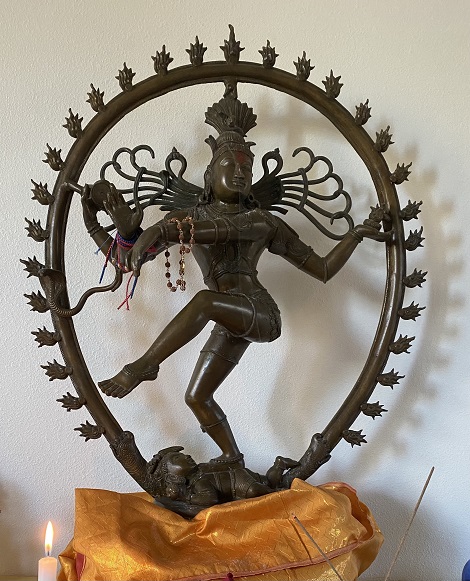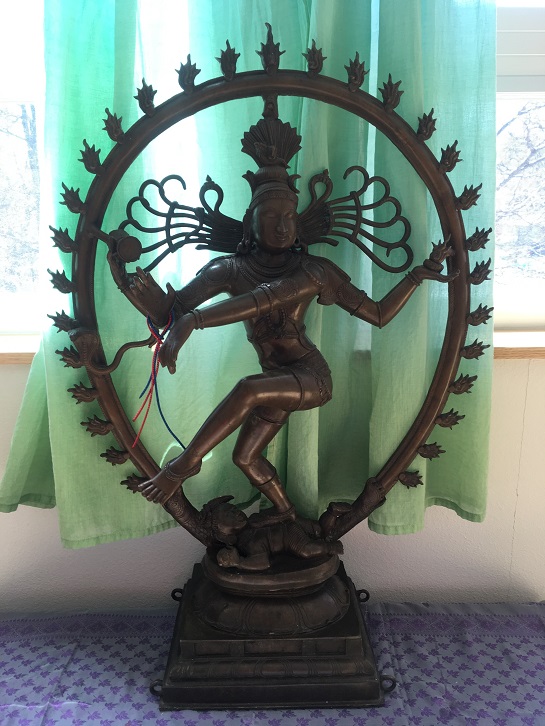Encoded into the image of Naṭarāja, the dancing are Śiva, are the pañca-kṛtyas, the five acts of Śiva. Pañca means “five.” Kṛtya comes from the verbal root kṛ meaning “to make or do.” So these are the five acts of the Highest. The pañca-kṛtyas/five acts are sṛṣṭi/creation, sthiti/maintenance, saṃhāra/dissolution, tirodhāna, vilaya, or nigraha/concealment, and anugraha/revelation or grace. There are different interpretations of this encoding of the pañca-kṛtyas onto the Śiva Naṭarāja, so see what resonates most for you.
The fourth act, nigraha, vilaya or tirodhāna, is concealment, and in one mapping it is represented by Naṭarāja’s standing leg. That foot stands on the dwarf Apasmāra, the demon of ignorance, who represents cosmic forgetfulness. Apasmāra is ajñāna or avidya, the lack of knowledge, or ignorance, of who we really are. We get lost in the wild dance of life and forget our true, essential nature, which is concealed. Here Śiva Naṭarāja literally stands upon ignorance, holding it at bay.
In another mapping, Śiva’s fourth act of concealment is represented by the arm that crosses Naṭarāja’s heart. That arm conceals the heart, and that downturned hand points to the upturned foot, which represents the fifth and last of the five acts: anugraha/grace or revelation. The arm crossing the heart closes off or “conceals” the heart, and that hand points the way to the antidote of the closed heart: the revelation represented by Naṭarāja’s beautiful, upturned foot—his kuñcita–pāda.
Paradoxically, Śiva performs these acts simultaneously. So there is a simultaneous dyadic process of nigraha/concealment and anugraha/revelation. As the Absolute creates the manifest world, the Absolute itself gets concealed. The Divine moves from its unmanifest perfection into manifest limitation. In order to manifest, the Divine must limit itself. There isn’t some other entity that conceals It. It creates and conceals itself. This is quite a paradoxical and mind-blowing teaching. I have heard it likened to a cosmic game of hide-and-seek the Divine plays with itself. It is simultaneously concealing and revealing itself. The Absolute limits itself by its own creative activity. One way to think about it is that when you choose to create one thing, that at least temporarily limits you to that one thing, out of the potential of all the things you could create. So as one thing is created and revealed, everything else is concealed.
Another way to think about this: as the unmanifest, unlimited, spacious Absolute takes on some form like an individual body, the very act of taking a body creates limitation. The expansiveness has to contract itself to take on the boundaries and limitations, squeezing itself into a bodily form.
In doing so, there is a forgetting of that original expansiveness. Naṭarāja stands on the dwarf of forgetfulness. His crossing arm occludes the heart in this gesture of forgetting. We forget that we are nothing but the great expansive ocean of Consciousness. Yet the hand of the crossing arm points to the upturned foot of grace, the other half of the dyad of concealment and revelation.
The heart of us, the essential Self, is covered over during the dance of manifestation into a human body. Yet our body and our embodied life is a vehicle for us to remember our essence, the heart of who we are. So the crossing hand points to the uplifted foot as a reminder of the possibility of a heart connection, to the very essence of ourselves.
That fifth act, grace, is a word that may have religious connotations for some of us. Yet by some circumstance, we find our way back home, so to speak, and remember the true Self. This is anugraha, vilaya, or tirodhāna, represented by Naṭarāja’s upraised foot.
So what is grace? You are invited to contemplate this for yourself, as there are many different ways to think about it. One way I think about grace is as anything that helps raise us up or connect us to the higher Self, to our hearts. It can simply be that which supports us in everyday life. But it is also that which leads us or opens us to that divine Sourceplace within ourselves.
When Śiva-Śakti contracts to embody as our individuality, we arrive on this planet forgetful of that source. Our innermost nature is concealed from us, yet by grace we can remember, and our divine Self is revealed to us. Each of us here now, when considering these teachings, is by grace receiving the gift of these teachings, which aids in uncovering and revealing our hearts to us.
Reflect and Explore
List and define the pañca-kṛtyas/five acts. Contemplate their meanings, and give examples from your life.
How do the different mappings of Naṭarāja inform your understanding?
How do the five acts relate to each other?
How do you experience concealment?
How have you experienced revelation/grace?









